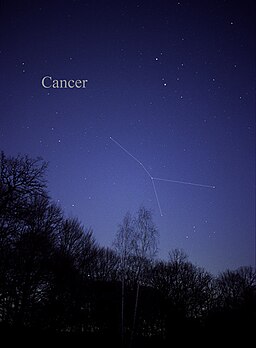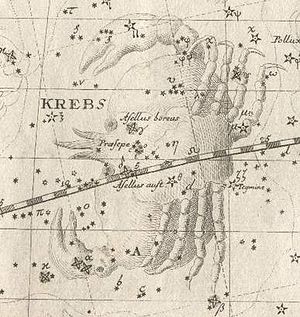Cancer (constellation)
|
Cancer constellation |
|
|---|---|
| Latin name | Cancer |
| Latin genitive | Cancri |
| Abbreviation | Cnc |
| Right ascension | 07 h 55 m 20 s to 09 h 22 m 35 s |
| declination | + 6 ° 28 ′ 12 ″ to + 33 ° 08 ′ 29 ″ |
| surface | 505.872 deg² rank 31st |
| Completely visible | 90 ° N to 57.1 ° S |
| Observation time for Central Europe | winter |
| Number of stars brighter than 3 mag | 0 |
| Brightest star (size) | Altarf (3.52) |
| Meteor streams | |
|
Neighboring constellations ( clockwise from north ) |
|
| swell | IAU , |
The cancer ( latin Cancer , astronomical signs ♋) is a constellation on the ecliptic .
description
Cancer is an inconspicuous constellation made up of relatively faint stars. The brightest, β Cancri ( Altarf ), only reaches the 3rd size class . The constellation is therefore a little difficult to spot. The best way to find it by an imaginary line between the prominent constellations Gemini (Gemini) and Leo follows (Leo). The stars of Cancer form an upside-down Y.
Cancer belongs to the signs of the zodiac , i.e. those signs of the zodiac through which the ecliptic runs. The sun is located in the constellation Cancer from July 21st to August 10th each year.
The constellation contains two interesting open star clusters : M 44 ( Praesepe , Nativity), which is already visible to the naked eye , and M 67 .
The constellation Cancer can be seen on the Slovenian 50 euro cent coin .
history
Already around 3000 BC In ancient Egypt , the constellation Cancer was known under the name Ab-Shetui and symbolized a turtle . In the New Kingdom, the constellation of the turtle was the scarab added that the immortality represented and how the turtle of death and rebirth of the Nile in connection with the Nile flood was. The Babylonians also saw a turtle in the constellation Cancer.
The ancient Greeks saw the constellation as a cancer. Ptolemy took it under this name in his description of the 48 constellations.
In an astronomical manuscript from the 12th century , the constellation is represented as a water beetle. In a work published in 1489 , the Arab astronomer Albumasar describes it as a crayfish . In Jakob Bartsch's maps from the 17th century , it is represented as a lobster .
In ancient times the sun reached the highest point of its orbit in Cancer, which marks the summer solstice . At this point the declination is + 23 ° 26 ', which corresponds to the angle at which the ecliptic is inclined in relation to the celestial equator . From this point the sun begins to descend again on its orbit. This is how the name Tropic of Cancer , which is still used today, for the northern tropic (23.5 ° north) arose. In all places on this latitude , the sun passes through the zenith on the day of the summer solstice .
However, due to the precession of the earth's axis , the summer point changed as early as 15 BC. In the twins and in 1990 in the constellation Taurus (according to today's constellation limits).
mythology
The cancer appears as a minor character in several Greek sagas and poems.
Zeus is said to have sent him to heaven as a reward for preventing a nymph from fleeing from the intrusive father of gods by pinching.
According to another origin, it is associated with the heroic deeds of Heracles . During his fight with the many-headed hydra , a giant crab appeared from the swamps and attacked the hero. Heracles, however, succeeded in trampling the monster. In gratitude, Hera , Zeus' wife , moved the crab to heaven. Heracles was hated by Hera because he was an illegitimate son of Zeus. Heracles and the Hydra were also immortalized in the sky as the constellations Hercules and the water serpent.
The names of the two stars Asellus Borealis (γ Cancri) and Asellus Australis (δ Cancri) mean northern and southern donkeys in Latin . According to mythology, they should represent two pack animals that carried the god Dionysus through several countries.
According to another myth, Dionysus rode the donkeys into a battle between the gods and giants. The giants, who had never seen animals like this before, panicked so much by the cries of the gray animals that they lost the battle.
Meteor streams
Around January 16 and 17, the Delta Cancriden meteor shower can be observed, the radiant of which is in Cancer.
Celestial objects
| B. | F. | Names or other designations | size | Lj | Spectral class |
|---|---|---|---|---|---|
| β | 17th | Altarf , Al Tarf, Tarf | 3.53 m | 230 | K4 III |
| δ | 47 | Asellus australis | 3.94 m | 150 | K0 III |
| ι | 48 | 3.9 m | 300 | G6 + A3 | |
| α | 65 | Acubens , Al Zubanah, Sertan, Sartan | 4.26 m | 180 | A3 |
| γ | 43 | Asellus Borealis | 4.66 m | 160 | A1 V |
| ζ | 16 | Tegmen | 4.7 m | approx. 82 | F7 V + F9 V + G0 V + M |
| RS | 5.0 to 5.6 m | 2000 | M6 II | ||
| χ | 18th | 5.13 m | |||
| 8th | 5.14 m | ||||
| ξ | 77 | 5.16 m | |||
| ο 1 | 62 | 5.22 m | |||
| κ | 70 | 5.23 m | |||
| ρ 2 | 58 | 5.23 m | |||
| σ 3 | 64 | 5.23 m | |||
| ρ 1 | 55 | Copernicus | 5.3 m | 45 | G8 + M3 |
| η | 33 | 5.33 m | |||
| θ | 31 | 5.33 m | |||
| π | 55 | 5.36 m | |||
| 57 | 5.40 m | 600 | G8 + K0 | ||
| τ | 72 | 5.42 m | |||
| σ 2 | 59 | 5.44 m | |||
| 60 | 5.44 m | ||||
| ν | 69 | 5.45 m | |||
| 27 | 5.56 m | ||||
| φ 1 | 22nd | 5.58 m | |||
| φ 2 | 23 | 5.6 m | 400 | A3 + A6 | |
| X | 5.6 to 7.5 m | 2000 | C6 II | ||
| 45 | 5.62 m | ||||
| 15th | 5.62 m | ||||
| 49 | 5.42 m | ||||
| σ 1 | 51 | 5.67 m | |||
| ο 2 | 63 | 5.68 m | |||
| υ 1 | 30th | 5.71 m | |||
| ψ | 14th | 5.73 m |
β Cancri is the brightest star in Cancer with an apparent magnitude of 3.52 m . It is a glowing orange giant star of spectral class K4 about 200 light years away.
The name Altarf comes from the Arabic and means "eye".
The stars γ and δ Cancri have the Latin names Asellus Borealis and Asellus Australis , "northern and southern donkey". They are 160 and 150 light years away, respectively. The star δ Cancri is in close proximity to the ecliptic. It is therefore sometimes covered by the moon or the planets .
α Cancri ( Acubens , Arabic "the scissors (of cancer")) is a 180 light-years distant star belonging to the spectral class A5.
Double stars
| object | Sizes | distance |
|---|---|---|
| φ 2 | 6.3 m / 6.3 m | 5.2 " |
| ι | 4.0 m / 6.6 m | 30.5 " |
| ρ 1 | 6.0 m / 6.2 m | 275 " |
| 57 | 6.0 m / 6.4 m | 1.4 " |
ρ 1 Cancri ( Copernicus ) is a binary star system 45 light years away, with a yellowish star of the spectral class G8 and a deep red shining star of the spectral class M3.
ι Cancri is 300 light years away and consists of two stars of the spectral classes G6 and A3. Both systems can be resolved into single stars with a smaller telescope . A larger telescope is required to separate the other double stars.
Variable stars
| object | size | period | Type |
|---|---|---|---|
| X | 5.6 m to 7.5 m | approx. 180 days | semi-regularly changeable |
| RS | 5.0 m to 5.6 m | approx. 120 days | semi-regularly changeable |
| DX | 14.8 m | ||
| HM | 21.0 m |
X Cancri is a semi-regularly changing star 2,000 light years away. It is deep red and belongs to the spectral class C6. The apparent brightness changes between 5.6 and 7.5 m every 180 days .
RS Cancri is also semi-regularly variable. It is also 2,000 light years away, very reddish and belongs to the spectral class M6. Its brightness varies between 5.0 and 5.6 m in about 120 days .
Messier and NGC objects
| Messier (M) | NGC | other | size | Type | Surname |
|---|---|---|---|---|---|
| M44 | 2632 | 3.5 m | Open star cluster | Praesepe | |
| M67 | 2682 | 7.0 m | Open star cluster |
In Cancer there are two open star clusters that the French astronomer and comet hunter Charles Messier included in his catalog of foggy objects ( Messier catalog ).
M44 , which is also known under the name Praesepe (crib), lies a little west of the imaginary line connecting γ Cancri and δ Cancri. It can already be seen with the naked eye on a dark night. In the binoculars he is a magnificent sight. M44 is about 500 light-years away and contains over 300 stars in size classes between 6 and 12 m .
M67 stands west of γ Cancri. In the binoculars it appears as a misty spot. In the telescope it is a very beautiful sight. M67 is 2,700 light years away and contains about 60 stars.
Planets
Around Copernicus A , an entire planetary system with five known exoplanets has been discovered in recent years . The system is located approximately 13 parsecs from the sun.
Individual evidence
- ↑ Introduction to Astronomy, Containing the Eight Divided Books of Abu Ma'shar Abalachus . In: World Digital Library . 1506. Retrieved July 16, 2013.
- ↑ 55 Cnc (English) - Entry in Extrasolar Planets Encyclopaedia
See also
Web links
- Cancer Constellation - A photographic journey through the signs of the zodiac


